Carlos Motta
by Mark Alice Durant
Originally published in Saint Lucy on September 17, 2012
In casual conversation Carlos Motta is understated and polite. He almost seems serene. When topics arise for which he is passionate, he remains courteous, yet a quiet fire sparks up just below the surface. He describes himself as “a multi-disciplinary artist whose work draws upon political history in an attempt to create counter narratives that recognize the inclusion of suppressed histories, communities, and identities.” This is an ambitious goal to say the least. But when you begin to comprehend the scope and depth of what he has accomplished thus far, it becomes clear that this is more than just rhetoric.
Carlos was born in Bogota, Colombia in 1978. He received his MFA from the Milton Avery Graduate School for the Arts at Bard College and attended the Whitney Independent Study Program. Motta’s work has been presented at The Guggenheim Museum and MoMA/PS1 Contemporary Art Center, Institute of Contemporary Art, Philadelphia; Museo de Arte del Banco de la República, Bogotá; Serralves Museum, Porto. Motta is currently working on a performative event co-commissioned by Electra Productions and Tate Modern Film, which will premiere in February 2013 at Tate Modern, London.
His 2012 exhibition at the New Museum, Museum as Hub: Carlos Motta: We Who Feel Differently, was a multi-part project that explored the idea of sexual and gender “difference” after four decades of Lesbian, Gay, Bisexual, Trans, Intersex, Queer, and Questioning politics.
This conversation took place at Carlos’ home in Manhattan on August 23, 2012.
MAD: Do you ever sleep?
CM: I have to sleep at least 8 hours per night, you?
MAD: Well I don’t sleep well in general plus I have a kid who gets up early. I ask because I am astounded by your productivity. Putting aside the creative aspects of it, there is a lot of work involved in your projects; the conceptualizing and shaping, there are so many logistics involved, negotiating people’s schedules to do interviews, editing and transcribing interviews, designing the websites, uploading material, the sheer amount of that is extraordinary.
CM: Negotiating with people is the nicest but the hardest part of my work process because depending on people’s schedule is very challenging. For instance, I am currently beginning a documentary project that will partially take place in India and it has been very hard to get folks over there to respond to my e-mails; I feel I will just have to show up and say and say “Hey, I’m here!” (Laughter)
MAD: I am interested in your evolution as an artist from an individual maker to someone who is in some ways a facilitator, mediator, director, in the sense that you set up certain structures and scenarios for other people to interact with. How has your conception of the artist’s role changed over the years?
CM: When I was a student I was quite focused on an individual studio-based practice where the act of making work was precise and solitary. But after graduating from school as I continued making work and started to show, I realized that being in the studio was the least interesting part of making work. It is not that I don’t like being alone, but rather that for me the process of making art is more exciting when it involves collaborating with other people— it is then that work gets activated in unexpected ways.
For example the project I have had on view this summer at the New Museum, We Who Feel Differentlypresents an interesting combination of those two modes of making work: It combines a group of objects produced in the studio with a video installation featuring five films composed of over forty interviews— all in a collaboratively designed space (with architect Daniel Greenfield) that serves as a discursive and social platform, which has housed hundreds of people together for public events. I am interested in how those different modes of production relate to one another aesthetically, conceptually and pragmatically.
MAD: That model is working at the New Museum show; it is not just a cold archive of gathered materials. It’s a very warm space, colorful and inviting for people to stay, sit and interact with the material and each other. There are public and private aspects to it, opportunities for contemplation and interaction. The stamp of the individual artist co-exists with the collective voice.
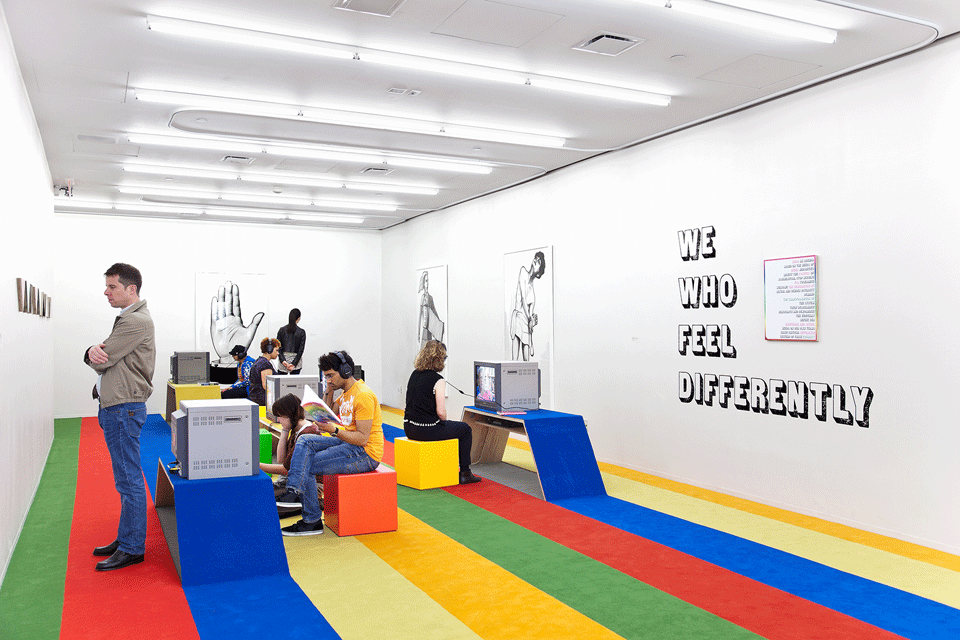
Carlos Motta, We Who Feel Differently, 2011-2012 multi-media installation installation view at the New Museum, New York Courtesy of Galeria Filomena Soares, Lisbon and Y Gallery, New York Photo: Naho Kubota
CM: I was visiting the show one day—I like to go sometimes and watch how people interact with the work—and a woman who was listening to one of the videos about the gay marriage debate, took of the headphones and started to engage the people around her in conversation. She was noticeably affected by what she was hearing. Witnessing this heated exchange made me realize the design of the space actually worked, because it was conducive to become a public forum. I was pleased to see how we had succeeded in designing a space where the work could be consumed individually but that also provided the opportunity to function as a space for conversation.
MAD: You provide a space for community interaction; the politics of that gesture is progressive, about acceptance of difference. But it is not in service of some feel good, ‘We are the World’ kind of thing, the politics can be challenging. For example, the issue of gay marriage, a right, I dare say, that most people of liberal or left-wing persuasions would support and even actively work for. That battle for equality is important obviously, but there is a strong presence in your show of voices that find this issue false or distracting, that are even antagonistic to what they see as an over-emphasis on the middle class and hetero-normative convention of marriage. So was that what this woman (you observed) reacting to?
CM: Yes, precisely. We Who Feel Differently reflects how within contemporary queer politics the issue of gay marriage is divisive and serves as a platform for foundational debates about the political strategy and priorities of the LGBT Movement. Advocating for gay marriage is strategically an issue that makes sense: We should pursue this kind of legislation in order to achieve an idea of perceived “equality.” But at the same time this fixation with gay marriage as the “ultimate” gay right, foregrounds the racist and classist aspects of a Movement, which tends to prioritize an agenda that serves a specific demographic and leaves other pressing social issues aside. We Who Feel Differently documents the work of activists and organizations that have brought this issue back to the table. So yes, you should be able to get married if so you choose, but should we be investing all the funds, time and effort for that purpose alone? Shouldn’t an inclusive agenda care for the panoply of injustices that Trans folks face every day for example, or for the rights of undocumented immigrants, for HIV/Aids research, or for the social conditions of the homeless? Sexual and gender liberation should transcend that limited view of equality.
MAD: I like your interviews with Douglas Crimp and Edmund White for a variety of reasons, but to this point specifically the bring a history to the discussion in terms of time when gay identity was more vividly associated with sex, transgression and not conforming to some conventional notion of what a couple is or what love looks like.
CM: I worked on another project last year with Joshua Lubin-Levy called Petite Mort: Recollections of a Queer Public in which we invited about 100 gay men to submit drawings from memory of public sites in which they had engaged in sex in New York City. Doing the research for that book it became really interesting for me to observe how issues about the body and sexuality are intimately related to the gentrification and neo-liberalization of public space (the city) as well as to the “bureaucratization” of the LGBT Movement.
In We Who Feel Differently, Douglas Crimp and Edmund White bring this up, how there is been a kind of sanitizing from the gay movement in order to present itself as a respectable community (note the singular), which requires a demonization of those who express their sexuality in non-normative ways—those who enjoy having sex out in public space with multiple partners for example, or those who don’t want to get married and live “normal” lives. Another interviewee, Colombian lawyer Esteban Restrepo, noted in this respect how those “who have made of promiscuity, of polygamy and of all those kinds of alternative forms of experiencing sexuality a way of living” have been transformed by the LGBT Movement proper into “pariahs among the pariahs.”
MAD: The interview is an important tool for you. You also explore graffiti as a form of public speech. In some of your projects people recite other peoples words in public spaces. Speech as gesture, as performance and as a historical record is central to your work.
CM: Ultimately, I use all those strategies in order to speak to the idea of self-representation. I am interested in constructing documentaries, archives, publications, and discursive projects where the subjects self-represent or self-determine the terms on which they desire to be represented. The interview as a form is very conducive to that, it is about delivering yourself in the way you want to be perceived. When you speak about marginalized politics that is very important, because often sexual minorities, immigrants and others who live at the margins of the patriarchal system are represented on the terms of the dominant center. I think the interview and all of these forms allow those representations to be generated on the margin and to speak to the center.
MAD: Yes, I was thinking about of the piece you did in Colombia Six Acts: An Experiment in Narrative Justice where you worked with six actors who read aloud, in public space, speeches delivered by presidential candidates that had been assassinated. I found that piece so sad and enraging simultaneously – a re-embodiment of public speech in which the words of the actors contributes to the ambient sound of the environment, like the ghostly exclamations of political martyrs. I appreciate the anger that fuels them but found the piece so lonely in a way.

Carlos Motta, Six Acts: An Experiment in Narrative Justice, 2010 six-channel video installation, dimensions variable installation view at Henie Onstad Kunstsenter, Oslo Courtesy of Galeria Filomena Soares, Lisbon and Y Gallery, New York
CM: In one the acts in Six Acts, there is a moment in which as one of the actresses is finishing her speech, a group of elderly protesters approach her believing that she was in fact running for office. So they make their demands of her, asking how she was going to address them, etc. This was one of the most interesting moments in my working life. It was the moment in which the space of representation—the actress embodying the words of a politician— clashed with reality. The space of representation was “ruptured” (see Jacques Ranciere) when they realized this was an act—it was a moment when esthetics and politics were vividly interconnected. They were disappointed at first but then a kind of empathy arose when they realized we were operating in a symbolic space that was sympathetic and in solidarity with their struggle.
MAD: Vik Muniz talks about growing up in Brazil in the 1970s – under a military dictatorship – that the content of what one was saying was always veiled, he calls it the ‘semiotic black market’. That what one meant was always something other or more than what one says out loud. This idea of saying one thing and meaning another is central to his work. You grew up in Colombia in the 80s and 90s, How did that environment shape you as an artist?
CM: That’s a difficult question: The 80s and 90s were probably the worst years to be growing up in Colombia in our recent history. But I have to preface this by saying I am a privileged Colombian, I grew up in the upper classes of society, had economic security, had opportunities to study and travel abroad—it’s important to to put that into perspective considering the abject poverty and lack of opportunities in which most of the country lives. However, growing up in those years was to grow up in the middle of a brutal State war against narco-terrorism. During the worst years you could be walking down the street in major cities and bombs would be set off, not to mention rural areas. It was also a time of extreme ideological clashes: some left-wing parties were operating as guerillas while others were attempting to join the political process. It was growing up in the middle of a civil war determined by extreme class, racial and economic differences. For most of my teenage years I chose to ignore it, it was too overwhelming a fact to deal with. But once I had a chance to leave to pursue my studies in New York, and I got some distance, I began to understand the place from which I wanted to speak. My work has never been specifically “about” Colombia, but I now recognize that it is shaped by the experience of conflict.
If there is a discursive aspect to my work, it is in part in response to how modern art dealt with the representations of politics. I felt the art-object-as-symbolic-gesture that evokes the political just wasn’t enough, there had to be another way to engage with a history of violence. If you look at the history of Colombian modern art, and see how these issues have been treated, for the most you will find works in which politics are bound to form and conceived to “move you.” It became important to me to attempt producing experiential, educational and discursive works— to make art that would offer another way to represent a history of systemic violence.
MAD: In thinking about the fiery and incisive rhetoric that characterizes so much of Latin American public discourse – it makes one realize how tepid and repressed progressive speech is in the U.S. A couple of obvious examples in the current Presidential election is that Gun Control and Climate Change cannot be discussed in any meaningful way because of the fear of being labeled a big government socialist, or environmental extremist. I know it’s a big question, but do you have any thoughts about that, or why public discourse in the U.S. is so intolerant of leftwing ideas?
CM: Let me attempt to answer that question by describing my project The Good Life in which I interviewed people on the streets of twelve Latin American cities about their perception of democracy as a form of government. I was really impressed by the level of discourse, how engaged people were with their countries’ political histories. People from all paths of life had very articulate positions and ideas about how politics affect their lives. In Latin America people recognize the things that are lacking—by comparison here in the U.S., I perceive a lack of acknowledgement of privilege.

Carlos Motta, Deus Pobre: Modern Sermons of Communal Lament, 2011 two-channel video installation, dimensions variable installation view at Y Gallery, New York Courtesy of Galeria Filomena Soares, Lisbon and Y Gallery, New York Photo: Carlos Motta
MAD: You did an amazing piece in Porto, Portugal in which you enlisted priests to recite passages from a variety of historical sources that express a critique of colonialism in the new world, including Bartolomé de las Casas who as bishop of Chiapas, Mexico was appointed ‘Protector of the Indians’ by the Pope. The priests recited these texts in their churches, in front of their congregations? Did the congregants know the context of what was going on?
CM: If you think in terms of temporality and context, these performances were so strange: People were coming to church on Sunday and their priest would be reciting texts written as far back as the 16th century by very radical priests. The project, which is named Deus Pobre: Modern Sermons of Communal Lament, deals with the history of Liberation Theology. It engages that theological and political project, which states that faith and the love of god should be unconditionally directed to service the poor. Liberation theologians confronted and critiqued the repressive and classist role of the church. I thought it would be interesting to do this project in/from Portugal, in order to question the imperial role of the Portuguese Crown and Portuguese church during the conquest but also to subscribe to a conversation about post-colonialism, which is central to Latin America today.
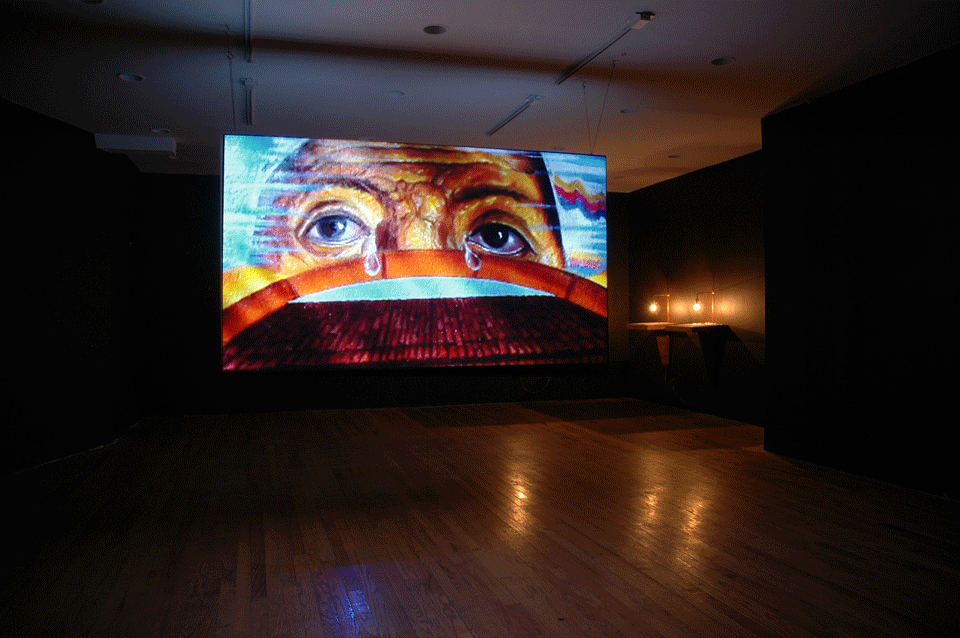
Carlos Motta, Deus Pobre: Modern Sermons of Communal Lament, 2011 two-channel video installation, dimensions variable installation view at Y Gallery, New York Courtesy of Galeria Filomena Soares, Lisbon and Y Gallery, New York Photo: Carlos Motta
MAD: These in-church performances were videotaped and projected onto a double-sided screen – one side showing the priests’ recitations, the other side showed impressionistic video montages of Latin American cities and landscapes.
CM: While I was shooting footage for The Good Life, I traveled all over Latin America, from Mexico to Argentina, collecting lots of material, so I have this huge archive of imagery. I have always been interested in the way contemporary Latin America looks at and memorializes its indigenous and colonial past: for instance how the presentation and preservation of archeological sites or monuments relate to religious buildings… So I drew from this archive to construct video sequences that interestingly illustrated the contradictions set forth by these juxtapositions in relationship to the texts.
MAD: Since both screens cannot be seen simultaneously, the viewer has to move back and forth. Is this re-positioning a strategy?
CM: If you choose to stand in front of the videos of the speeches you can listen to the texts (if you understand Portuguese) or read the subtitles, but if you stand on the other side watching the images of the landscapes, sites and rituals, you can still hear the texts but you don’t have access to the subtitles, hence you encounter only images with a foreign soundtrack. I liked the dilemma this creates, which mimics the cultural clash that happened there in the first place.
MAD: Like the historical accounts in which Conquistadores would announce to native peoples some royal edict in Spanish or Portuguese, which if not followed would have dire consequences, and when the natives, who obviously did not understand those languages, did not acquiesce, the Conquistadores justified the ensuing atrocity by claiming the natives had disobeyed the word of god.
CM: Exactly.
MAD: Another challenging aspect of this piece has to do with the presumption that we are entitled to understand anything at any given moment. Your work requires patience because the experience unfolds over time.
CM: I am interested in a certain contractual engagement between the work and its audience. I am fascinated by the multiple levels which a viewer can engage a work. The experience of a work can shift depending on what aspect of it you choose to “see” at any given moment—hopefully the experience of the work is deepened through the subtle formal and aesthetic considerations we have been talking about today.
MAD: For the New Museum project, We Who Feel Differently, there are at least three interdependent iterations; there is the installation itself, the catalog and the web archive. Can you talk about how these interact with each other?
CM: We Who Feel Differently is structured around an online archive (wewhofeeldifferently.info), which is the core of the work, the site where every aspect of the larger project is archived. When I am doing a social project like this, I tend to favor the form or a website because that is the way most people can access the project.
The installation on view at the New Museum was conceived as a way of making concrete and of distilling the key issues of the project in an exhibition/social space. I worked together with my sister Cristina Motta to identify a few of the central themes addressed in the interviews. We went through forty hours of interviews and identified five themes —discursive and topical aspects of sexual and gender politics. With that edit as the template we edited a book and I edited the videos accordingly for the installation.
Although it is daunting, the forty hours of interviews live on the website and people can come back to them whenever they like. The installation on the other hand is a temporary meeting and discursive space. And the book is the document, a summary, and a thesis…
There are two other pieces included in the New Museum exhibition, the documentation of A New Discovery: Queer Immigration in Perspective, a collaborative performance/intervention QUEEROCRACY and I did at Columbus Circle in New York City and Shapes of Freedom: Triangle, a sculptural and sonic piece about the history of the pink triangle. This last piece not only provides a timeline of the use of that emblem in gay history but it also references its use by minimalist artists. I wanted to contrast the social/semantic use of that shape to the purely formal in art.
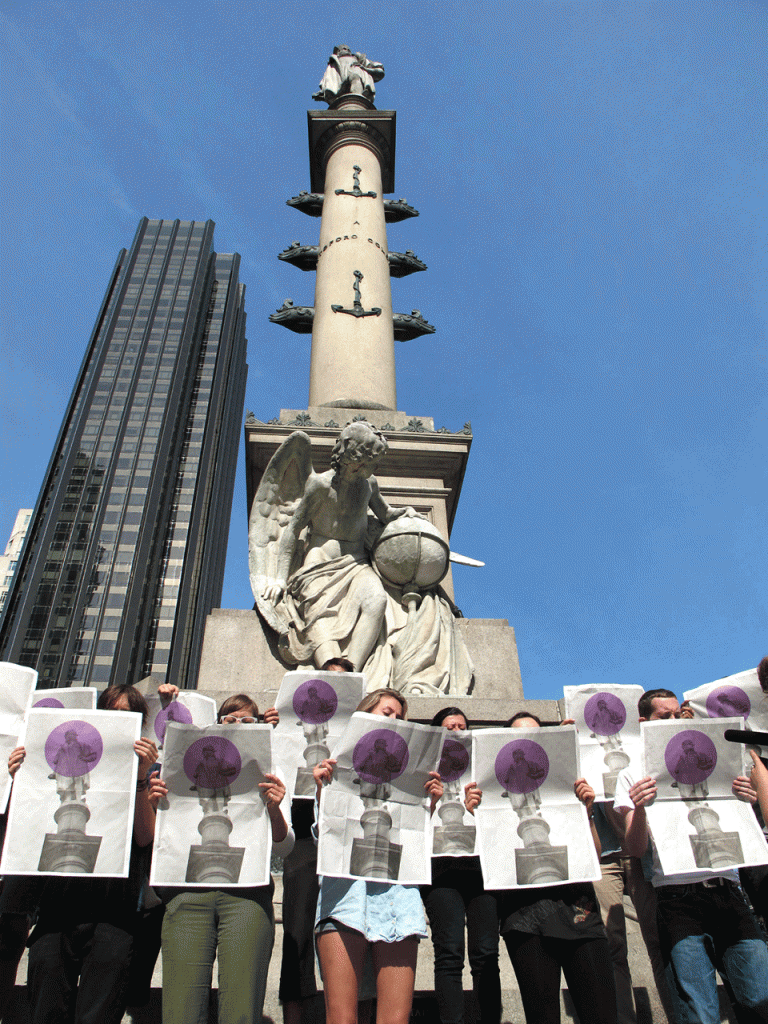
QUEEROCRACY and Carlos Motta, A New Discovery: Queer Immigration in Perspective, 2011 social intervention in Columbus Circle Photo: Anna Barsan
MAD: A New Discovery: Queer Immigration in Perspective involved several dozen people, including yourself reading from a news print timeline of Gay rights and abuses of those rights as they apply to crossing borders. You have worked extensively with the idea of the monument, here, in Russia, Latin America and other places. I suspect this has to do with your attempt to create a counter-narrative to the founding myths of power. You oppose the grandeur and silence of these monuments with transitory gestures; in their very lack of physicality they are the antithesis of monuments. Can you elaborate on that a bit?
CM: When I think of monuments I think about this idea that there are some lives are worth remembering or commemorating and some that are not. With patriarchal figures such as Columbus, something permanent must be erected whereas for, say, the AIDS epidemic there is nothing like in place—not that there should be one necessarily, especially since AIDS is still happening—but it suggests that there are lives that mean less than others—I suppose that is how power is exercised. Through my work I want to create temporary or ephemeral counter-monuments that speak to those lives that were lost or affected by those erect people in the monuments.

Carlos Motta, Pesca Milagrosa, 2002-2004 photographic installation 13 x 25′ installation view at Artists Space, New York Courtesy of Galeria Filomena Soares, Lisbon and Y Gallery, New York
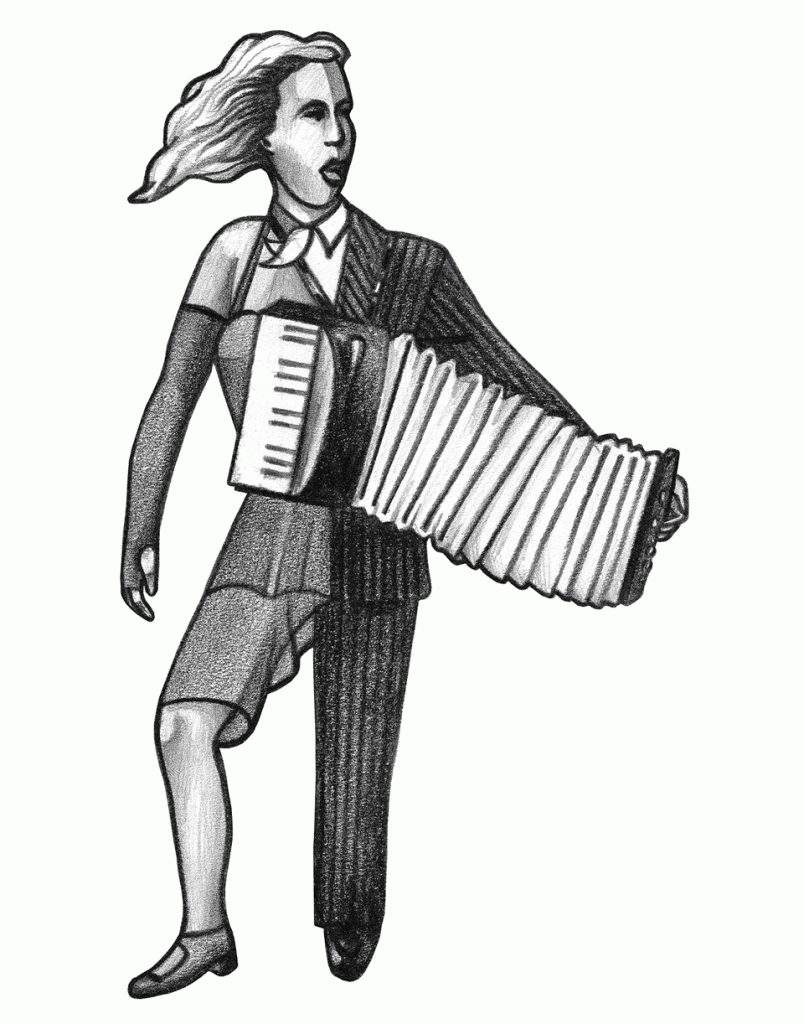
Carlos Motta, ‘Our Music’ from We Who Feel Differently, 2011-2012 75 x 45″ archival inkjet print Courtesy of Galeria Filomena Soares, Lisbon and Y Gallery, New York
MAD: One last observation about the New Museum show. The room is comfortable with this terrific multi-colored striped rug running the length of the gallery. I also loved the four large images on the wall. Which are inspired by the Mexican card game La Loteria, right? The images include a hand, a hermaphrodite playing an accordion, a bound slave and a tall androgynous figure draped in a robe…
CM: The hand became the emblem of We Who Feel Differently. It is indeed appropriated from La Loteria except that I changed the button on the shirt to a little heart, which to me speaks of the shift towards affect within the Political that the project puts forth. The hand to me represents the “queering” of the citizen. It is a hand that is calling attention to itself—as if to say, “I feel from here.”
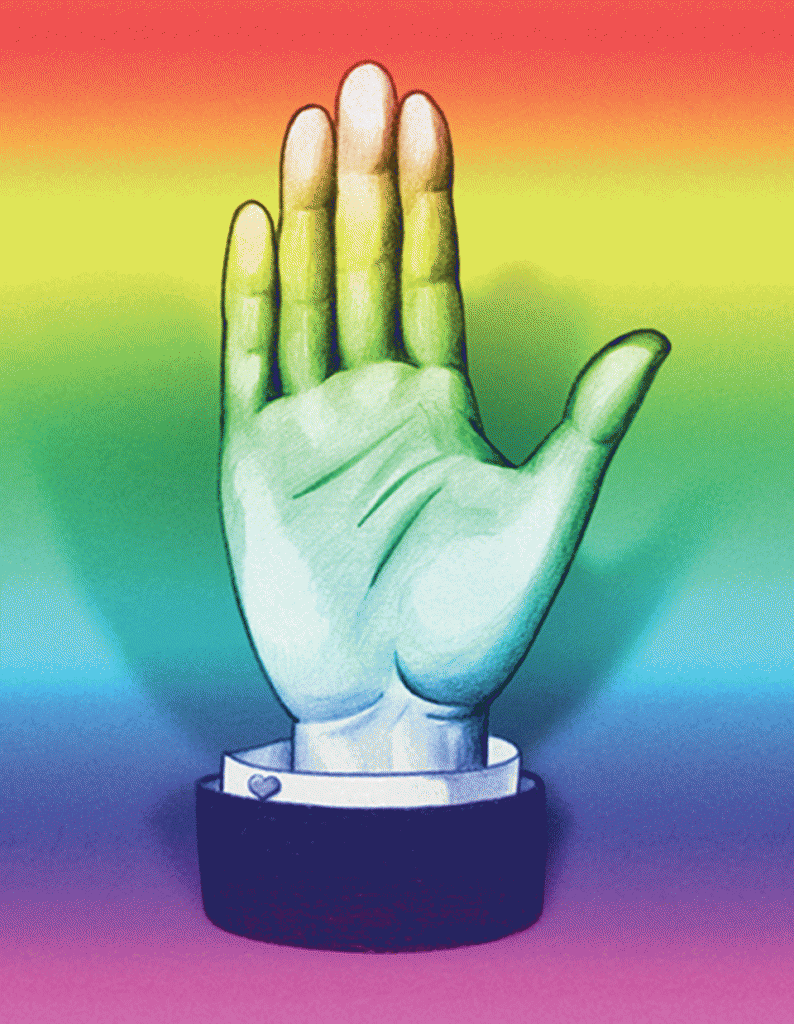
Carlos Motta, ‘Our Hand’ from We Who Feel Differently, 2011-2012 project’s emblem installation view at the New Museum, New York Courtesy of the artist
MAD: It seems so corny, but I am going to say it anyway… It reminds me of what Che Guevera said that the true revolutionary is guided by great feelings of love. Obviously there is anger and confrontation in your work but also a desire for communication and connection between people, there is a gentle sensibility present.
CM: The relationship between love and democracy is a very important idea that to me. I became interested in it as I produced The Good Life —before that I had a very narrow understanding of the extent of what is deemed “Political.” I never thought the “Political” had anything to do with our personal lives. But as I interviewed people of all paths of life, more and more people were drawing connections between politics and emotions. A man in Tegucigalpa told me “for democracy there must be love.” His statement was revelatory to me. He led me to think about how we could recuperate the world of emotions and affect and insert back into political discourse.
Having worked with the interviewees and the many participants of the events around We Who Feel Differentlyhas deepened my understanding that to construct a political discourse is important to be able to define and represent yourself, but what is ultimately more important is the experience of standing in front of someone, looking at them in the eye and recognizing their existence and the place from where they stand—however different it may be from your own. It may sound corny but I have learned through working so intimately in projects “about” sexual and gender difference that this most important thing ever: being able to recognize that there is someone in front of you, not an idea of a person, not a construction of an identity, but someone with a very specific life and history. The lesson for me of We Who Feel Differently is to acknowledge the person in front of you when you look at them in the eyes.
